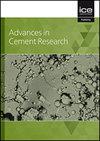Features of Immittance Spectra as Performance Indicators for Cement-Based Concretes
IF 1.3
4区 工程技术
Q3 CONSTRUCTION & BUILDING TECHNOLOGY
引用次数: 1
Abstract
The design for durability and performance-based standards and specifications for reinforced concrete infrastructure, is limited by the lack of rapid, science-based test methods for characterizing the deterioration resistance of concrete. In this paper, this issue is addressed though the application of two-point electrical impedance measurements taken within the frequency range 100Hz-10MHz. Data are presented for a range of industry-standard cement-based concrete mixes with and without supplementary cementitious materials (SCM's). The Nyquist (-iZ’’(ω) vs Z’(ω) and Bode (Z*(ω) and θ vs frequency) formats clearly highlight the frequency dependence of the electrical response, however, when presented in the form of permittivity and conductivity, a region of dispersion was evident over the entire frequency range for all concretes. Features of this response, which could be gainfully exploited as durability indices for assessing the long-term performance of concrete, are identified and discussed. A range of formalisms is presented, and it is shown that within this frequency range the conductivity was found to obey Jonscher's universal power-law. Two novel durability parameters are presented based on features of Jonscher's model and, from a practical viewpoint, the power-law model can be evaluated using conductivity measurements obtained at three, easily measured, spot frequencies (viz. 10kHz, 1MHz and 10MHz).作为水泥基混凝土性能指标的阻抗谱特征
由于缺乏快速、科学的测试方法来表征混凝土的抗劣化性能,钢筋混凝土基础设施的耐久性和基于性能的标准和规范的设计受到了限制。在本文中,通过在100Hz-10MHz频率范围内进行两点电阻抗测量来解决这个问题。数据提出了一系列工业标准水泥基混凝土混合料,有和没有补充胶凝材料(SCM)。Nyquist (-iZ”(ω) vs Z”(ω)和Bode (Z*(ω)和θ vs频率)格式清楚地强调了电响应的频率依赖性,然而,当以介电常数和电导率的形式呈现时,在所有混凝土的整个频率范围内都明显存在色散区域。识别和讨论了这种响应的特征,可以有效地利用作为评估混凝土长期性能的耐久性指标。给出了一系列的形式,并表明在这个频率范围内,电导率服从琼舍尔的普遍幂律。基于Jonscher模型的特征,提出了两个新的耐久性参数,从实用的角度来看,幂律模型可以通过在三个易于测量的点频率(即10kHz, 1MHz和10MHz)下获得的电导率测量来评估。
本文章由计算机程序翻译,如有差异,请以英文原文为准。
求助全文
约1分钟内获得全文
求助全文
来源期刊

Advances in Cement Research
工程技术-材料科学:综合
CiteScore
3.70
自引率
5.00%
发文量
56
审稿时长
3.2 months
期刊介绍:
Advances in Cement Research highlights the scientific ideas and innovations within the cutting-edge cement manufacture industry. It is a global journal with a scope encompassing cement manufacture and materials, properties and durability of cementitious materials and systems, hydration, interaction of cement with other materials, analysis and testing, special cements and applications.
 求助内容:
求助内容: 应助结果提醒方式:
应助结果提醒方式:


